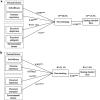Fact-checking of health information on social networking sites: The moderating role of gender
- PMID: 40766857
- PMCID: PMC12322368
- DOI: 10.1177/20552076251365004
Fact-checking of health information on social networking sites: The moderating role of gender
Abstract
Background: This study aims to explore the factors related to fact-checking health information and the moderating role of gender on the effects of explored factors. Based on social cognitive theory (SCT) and social role theory (SRT), we established a research model to explore the factors of fact-checking on health information and the role of gender.
Methods: To validate the research model, data were collected by survey method and analyzed by partial least squares technique.
Results: The analysis results present that personal factors (self-efficacy and outcome expectancy), and environmental factors (perceived skepticism and perceived ambiguity) have significant impacts on fact-checking about health information. Meanwhile, our results reveal that gender moderates the effects of outcome expectancy, perceived skepticism, and perceived ambiguity on users' fact-checking.
Conclusion: Our study uses SCT to explore the factors impacting fact-checking, while we combine it with SRT to understand the gender differences in the process of fact-checking health information in social networking sites.
Keywords: Fact-checking; gender differences; social cognitive theory; social networking sites; social role theory.
© The Author(s) 2025.
Conflict of interest statement
The authors declared no potential conflicts of interest with respect to the research, authorship, and/or publication of this article.
Figures



Similar articles
-
How lived experiences of illness trajectories, burdens of treatment, and social inequalities shape service user and caregiver participation in health and social care: a theory-informed qualitative evidence synthesis.Health Soc Care Deliv Res. 2025 Jun;13(24):1-120. doi: 10.3310/HGTQ8159. Health Soc Care Deliv Res. 2025. PMID: 40548558
-
Gender differences in the context of interventions for improving health literacy in migrants: a qualitative evidence synthesis.Cochrane Database Syst Rev. 2024 Dec 12;12(12):CD013302. doi: 10.1002/14651858.CD013302.pub2. Cochrane Database Syst Rev. 2024. PMID: 39665382
-
A New Measure of Quantified Social Health Is Associated With Levels of Discomfort, Capability, and Mental and General Health Among Patients Seeking Musculoskeletal Specialty Care.Clin Orthop Relat Res. 2025 Apr 1;483(4):647-663. doi: 10.1097/CORR.0000000000003394. Epub 2025 Feb 5. Clin Orthop Relat Res. 2025. PMID: 39915110
-
Sexual Harassment and Prevention Training.2024 Mar 29. In: StatPearls [Internet]. Treasure Island (FL): StatPearls Publishing; 2025 Jan–. 2024 Mar 29. In: StatPearls [Internet]. Treasure Island (FL): StatPearls Publishing; 2025 Jan–. PMID: 36508513 Free Books & Documents.
-
The World According to Girls: A Qualitative Study of School, Work, and Identity Among Adolescent Girls and Young Women Living with HIV in Ghana.medRxiv [Preprint]. 2025 Jul 23:2025.07.22.25331754. doi: 10.1101/2025.07.22.25331754. medRxiv. 2025. PMID: 40778157 Free PMC article. Preprint.
References
-
- Guidry JPD, O’Donnell NH, Meganck SL, et al. Tweeting a pandemic: communicating #COVID19 across the globe. Health Commun 2023; 38: 2377–2386. - PubMed
-
- Papa V, Maniou T. Recurrent narratives around the COVID-19 crisis in social networks: a case study analysis on Facebook. Tripodos 2020; 2: 11–27.
-
- Cao B, Wang L. When epidemic outbreaks meet social Media: collective illness narratives on WeChat during COVID-19 omicron infection in China. Health Commun 2023; 39: 1–14. - PubMed
-
- Apuke OD, Omar B, Tunca EA, et al. Does misinformation thrive with social networking site (SNS) dependency and perceived online social impact among social Media users in Nigeria? Testing a structural equation model. J Asian Afr Stud 2024; 59: 307–322.
LinkOut - more resources
Full Text Sources

